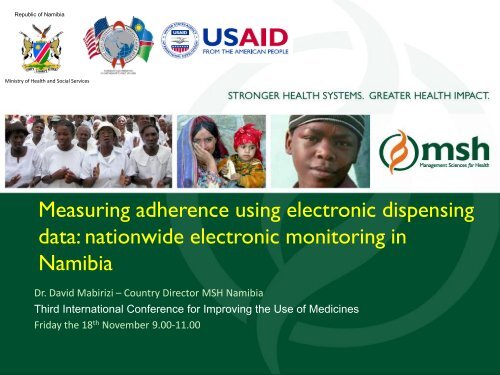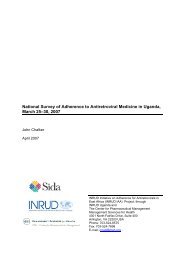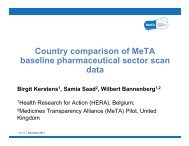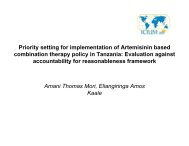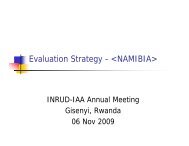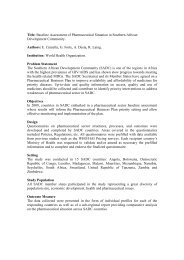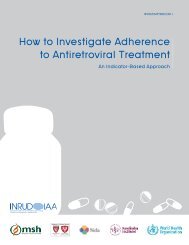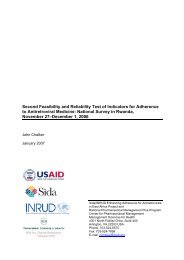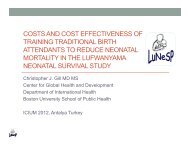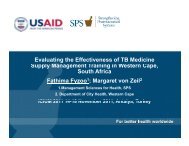Measuring adherence using electronic dispensing data ... - INRUD
Measuring adherence using electronic dispensing data ... - INRUD
Measuring adherence using electronic dispensing data ... - INRUD
Create successful ePaper yourself
Turn your PDF publications into a flip-book with our unique Google optimized e-Paper software.
Republic of Namibia<br />
Ministry of Health and Social Services<br />
<strong>Measuring</strong> <strong>adherence</strong> <strong>using</strong> <strong>electronic</strong> <strong>dispensing</strong><br />
<strong>data</strong>: nationwide <strong>electronic</strong> monitoring in<br />
Namibia<br />
Dr. David Mabirizi – Country Director MSH Namibia<br />
Third International Conference for Improving the Use of Medicines<br />
Friday the 18 th November 9.00-11.00<br />
1
Acknowledgement<br />
Ms. Jennie Lates<br />
Johannes Gaeseb<br />
Ms. Dawn Pereko<br />
Mr. Evans Sagwa<br />
Mr. Victor Muthiani<br />
Mr. Samson Mwinga<br />
All staff at health facilities and at the MoHSS Headquarters<br />
Mr. Jude Nwokike<br />
Funding from USAID<br />
Republic of Namibia<br />
Ministry of Health and Social Services<br />
2
Outline<br />
Background<br />
The Namibia setting<br />
Goal and Challenges<br />
Intervention – Electronic Dispensing Tool (EDT)<br />
Key experiences<br />
Reports<br />
Results<br />
Recommendations<br />
3
Background – Namibia<br />
Location – South West Africa<br />
Population 2,114,161<br />
Sparsely Populated - 2 persons/sq km<br />
4
Sossosvlei Dunes, Namib National Park, Namibia...<br />
The Namibia Setting<br />
Large country<br />
Long distances between facilities<br />
The cost of travel<br />
– time<br />
– funding<br />
High HIV burden<br />
– HIV prevalence – 13.3% ,<br />
– ANC prevalence ranges from 8% - 35%<br />
– People Living with HIV – est. 204,000<br />
Limited Human resources<br />
Good 3G coverage<br />
Electricity supply in more than<br />
90% of facilities<br />
5
6<br />
Goal and Challenges in the delivery of ART<br />
The Goal of the MoHSS with support from Development partners<br />
– Rapid Scale up to cover 80% of people in need of ART<br />
At the start of the program 2003 – 2008<br />
– limited ART sites across the country initially limited to 30 District and 4 Referral<br />
Hospitals and 2-3 health centers<br />
– long distances to ART sites<br />
– collection and retrieval of information on ART service delivery was paper based<br />
(time consuming, usually late, incomplete, untimely)<br />
– inadequate <strong>data</strong> on enrolment and ARV consumption resulting increased risk<br />
of out of stock<br />
Current challenges 2009 – 2011<br />
– Increased number of sites and access through IMAAI/outreach sites (from 34 to<br />
more than 100)<br />
– Increased number of patients from 36,881(June 2007) to 95,388 (June 2011)<br />
Adherence monitoring is even more urgent
7<br />
Intervention<br />
The MoHSS Namibia decided on an Electronic Dispensing Tool (EDT)<br />
with USAID funding,<br />
– The tool is a Microsoft SQL based tool<br />
– Used in all Pharmacies at ART sites to dispense ARVs and at<br />
outreaches <strong>using</strong> a mobile EDT<br />
– Patient <strong>data</strong> is encrypted<br />
– It is user friendly – can be used by Pharmacists, Pharmacist’s<br />
Assistants and Nurses<br />
– All <strong>data</strong> is transmitted <strong>electronic</strong>ally from facilities to a central<br />
National <strong>data</strong>base at the Ministry of Health <strong>using</strong> 3G<br />
– Allows multi user access and use<br />
– Accommodates mobiles applications and updates<br />
– The tool is easily adaptable to country settings and changing<br />
requirements
The EDT at facilities<br />
8
The handover of the system to the Ministry<br />
9
Key experiences<br />
– A customized tool<br />
– Ongoing support to facilities is imperative<br />
– All patient <strong>dispensing</strong> <strong>data</strong> is <strong>electronic</strong> thus – easy and reliable retrieval<br />
– Consumption <strong>data</strong> is available at site and national levels<br />
– The national <strong>data</strong>base ensures a comprehensive/rich Quarterly report<br />
• Adherence monitoring approaches used<br />
– Pill Count<br />
– On time pick up of medication<br />
» Pill coverage<br />
– Individual patient monitoring for <strong>adherence</strong><br />
– The Namibia Adherence Initiative<br />
10
11<br />
Reports: Patients starting treatment<br />
This report shows a snap shot for new patients<br />
Facility<br />
name<br />
Date<br />
filter<br />
Report number<br />
Indicator<br />
description
12<br />
Report: status change<br />
General reports
13<br />
Report: <strong>adherence</strong> levels<br />
Patient <strong>adherence</strong> level<br />
Patient<br />
number
14<br />
Report: <strong>adherence</strong> <strong>using</strong> pill count<br />
Facility <strong>adherence</strong> level
15<br />
Report: <strong>adherence</strong> <strong>using</strong> pill count<br />
Facility <strong>adherence</strong> patterns
16<br />
Report: <strong>adherence</strong> <strong>using</strong> on-time pickup<br />
On time pick up defined as within ±4 days of the appointment
17<br />
Report: <strong>adherence</strong> <strong>using</strong> on-time pickup<br />
On time pick up defined as within ±4 days of the appointment
18<br />
Results<br />
On-time pick-up of 33 health facilities for June 2011<br />
– National average of 88% on-time pick-up<br />
– Best performing hospitals on-time pick-up 98%<br />
– Poorly performing hospitals on-time pick-up 63%<br />
All hospitals can generate monthly reports on <strong>adherence</strong> indicators<br />
– on-time ARV pick-up/pill count/lost to follow-up and other<br />
<strong>adherence</strong> indicators and develop interventions accordingly<br />
• e.g. Facilities prepare lists of patients who missed appointments<br />
and follow them up<br />
Individual patient’s on-time ARV pick-up and pill count patterns can<br />
be monitored and appropriate remedial measures taken
19<br />
Namibia <strong>adherence</strong> initiative<br />
With funding from USAID<br />
Namibia has developed an <strong>adherence</strong> monitoring initiative which<br />
includes;<br />
– Three national patient surveys over a 3 year period to determine;<br />
• Baseline <strong>adherence</strong> levels and routinely monitor performance<br />
based on these baselines<br />
• Factors associated with good or poor <strong>adherence</strong><br />
– patient related<br />
– facility related and<br />
– Health worker related<br />
• Initiatives implemented by facilities to improve <strong>adherence</strong><br />
– Designing, Piloting and implementing effective interventions<br />
– Ongoing monitoring <strong>using</strong> the WHO HIV DR strategy
Recommendations for<br />
policy and program action<br />
20<br />
Basis of recommendations<br />
• Increasing number of patients ART/HAART<br />
• Patients living longer on ART<br />
Increasing need for rational and cost effective management of HIV<br />
patients with a multitude of medicines available for the same<br />
condition<br />
– systems that will enhance <strong>adherence</strong> monitoring are imperative<br />
– standardization of the Adherence indicators, measurement and<br />
reporting<br />
– Adaptable user friendly Electronic Systems (suitable and appropriate<br />
for the setting)<br />
– Health facility level and national levels should routinely monitor and<br />
regularly review <strong>adherence</strong> parameters and develop targeted<br />
interventions to enhance <strong>adherence</strong>


